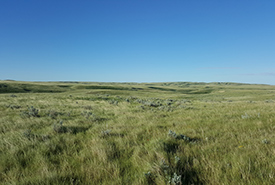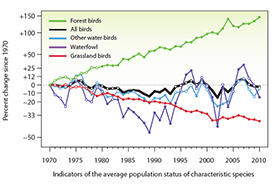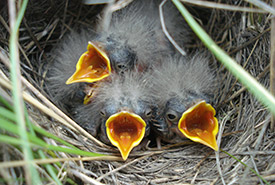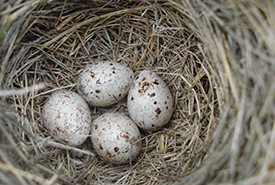Native grassland is important habitat for grassland birds

Native grassland (Photo by Sarah Ludlow/NCC staff)
Saying that native grassland is important habitat for grassland birds seems quite obvious. And you might think to yourself, “Of course grassland birds like grassland habitat; it’s right in the name!” The important point to note is the part about native grassland. So what are native grasslands, and what makes them so special?
Temperate grasslands are among the most imperiled ecosystems globally. This means that across the world, this type of habitat has been and continues to be lost at alarming rates.
Grasslands occur in areas where it is too dry for trees to survive. In Canada, most grassland habitat exists in the prairie ecozone, which covers the southern portions of Alberta, Saskatchewan and Manitoba. Within Canada, it is estimated that less than 20 per cent of native grassland remains. The main reason for much of this habitat loss is the conversion of the land for annual agriculture.
Much of the remaining intact patches of native grassland are used for cattle grazing, with conversion of these grasslands to annual cropland often tied to decreases in cattle prices (i.e., sometimes it is more profitable to grow canola than cows). This highlights another important point: cattle ranching is essential to the conservation of native grasslands. So now that we have a bit of background on native grasslands, let’s get back to the birds.
Related blog posts

Change in population status of different bird groups in Canada from 1970 to 2010 (Graph from State of Canada’s Birds 2012)
As you can imagine, the loss of significant amounts of habitat has an effect on the species that depend on that habitat. Indeed, grassland birds have experienced some of the steepest population declines. Since the 1970s, populations of grassland birds on the Canadian Prairies have declined by 30 to 88 per cent. Many of these species are grassland obligates, meaning that they require grassland habitat for their entire life cycle.
One strategy used to restore habitat for grassland birds is to plant cultivated areas with perennial grasses, which are then used as pasture and hay for livestock. These planted perennial grasslands often involve grasses that are non-native to North America. For these areas to be effective in conserving habitat for grassland birds, the birds must do equally well in the planted grasslands as they would in native grasslands.
A recent study was conducted to test exactly that. Specifically, it sought to determine if the abundance and reproductive success of grassland songbirds differed between planted and native grassland, or with the amount of grassland in the surrounding landscape. The study was conducted in the Missouri Coteau in Saskatchewan and included these nine songbird species:
- Sprague’s pipit
- chestnut-collared longspur
- clay-coloured sparrow
- vesper sparrow
- lark bunting
- savannah sparrow
- grasshopper sparrow
- Baird’s sparrow
- western meadowlark

Sprague's pipit chicks (Photo by Sarah Ludlow/NCC staff)
Of these nine species, four are currently of conservation concern in Canada: Sprague’s pipit, chestnut-collared longspur, Baird’s sparrow and lark bunting.
So what did the researchers find? Are planted grasslands equally good habitat as native grasslands for the four at-risk grassland songbird species? The short answer is no. Planted grassland is lower-quality habitat than native grassland for these four species. The results of the study suggest that planted grasslands are likely ecological sinks for the four species. An “ecological sink” is habitat that sees more birds coming into it than going out (i.e., birth and immigration rates are lower than death rates). As a result, these habitats do not contribute to population growth.

Chestnut-collared longspur eggs (Photo by Sarah Ludlow/NCC staff)
The main message to take away is that the conservation of native grassland is critical for stabilizing the population declines of these four at-risk grassland songbird species. These species either only occurred in native pasture, or they had higher reproductive success in native pasture than in planted grasslands that were used for pasture or hay.
Other bird species that have more general habitat requirements would likely benefit from the conservation of both native and planted grassland, as well as the conversion of cropland to perennial grassland. To be most effective for conservation, the conversion of cropland to perennial grassland should expand existing grassland patches, rather than creating islands of grass in a sea of cropland.
I presented the results of this study as a webinar as part of Saskatchewan Prairie Conservation Action Plan’s “Prairies Got the Goods” Week 2019. You can check out the presentation here.
References
Davis, S. K., Ludlow, S. M., & McMaster, D. G. (2016) Reproductive success of songbirds and waterfowl in native mixed-grass pasture and planted grasslands used for pasture and hay. The Condor: Ornithological Applications, 118(4), 815-834. https://doi.org/10.1650/CONDOR-16-16.1
North American Bird Conservation Initiative Canada. 2012. The State of Canada's Birds, 2012. Environment Canada, Ottawa, Canada. 36 pages.


